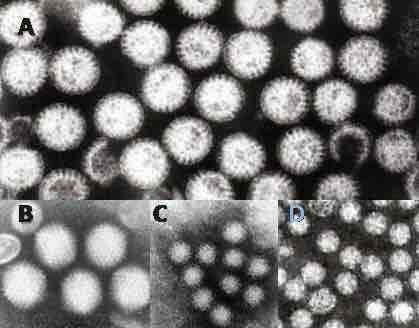Gastroenteritis is a medical condition characterized by inflammation ("-itis") of the gastrointestinal tract that involves both the stomach ("gastro"-) and the small intestine ("entero"-), resulting in some combination of diarrhea, vomiting, abdominal pain and cramping. Gastroenteritis has also been referred to as gastro, stomach bug, and stomach virus. Although unrelated to influenza, it has also been called stomach flu and gastric flu.
Viruses that are known to cause gastroenteritis include rotavirus, norovirus, adenovirus, and astrovirus . Globally, Rotavirus is the most common cause of gastroenteritis in children, and produces similar incidence rates in both the developed and developing world. In adults, norovirus and Campylobacter are more common causes.

Gastroenteritis Viruses
Electron Micrographs of viruses that cause gastroenteritis in humans. A = rotavirus, B = adenovirus, C = norovirus and D = astrovirus. They are shown at the same magnification of approximately x 200,000
Viruses cause about 70% of episodes of infectious diarrhea in the pediatric age group. Rotavirus is a genus of double-stranded RNA virus in the family Reoviridae. Reoviruses are non-enveloped and have an icosahedral capsid composed of an outer and inner protein shell. The genomes of viruses in Reoviridae contains 10-12 segments which are grouped into three categories corresponding to their size: L (large), M (medium) and S (small). Segments range from ~ 3.9 kbp – 1kbp and each segment encodes 1-3 proteins. Since these viruses have dsRNA genomes, replication occurs exclusively in the cytoplasm and the virus encodes several proteins which are needed for replication.
The virus can enter the host cell via a receptor on the cell surface. The receptor is not known. After binding to the receptor the outer shell is partially digested to allow cell entry. The inner shell particle then enters the cytoplasm by a yet unknown process to start replication. Viral particles begin to assemble in the cytoplasm 6–7 hours after infection.
Rotavirus is a less common cause in adults due to their acquired immunity. Norovirus is the leading cause of gastroenteritis among adults in America, causing greater than 90% of outbreaks. Noroviruses contain an RNA genome of approximately 7.5 kbp, encoding a major structural protein (VP1) and a minor capsid protein (VP2). The virus particles demonstrate an amorphous surface structure when visualized using electron microscopy and are between 27-38 nm in size.
The most variable region between different viruses of the same type is a portion of the viral capsid. Specifically a region which contains antigen-presenting sites and carbohydrate-receptor binding regions, which is probably the region of the virus that binds to target cells. The estimated mutation rate (1.21 x 10-2 to 1.41 x 10-2 substitutions per site per year) in this virus is high, even compared with other RNA viruses. Norovirus epidemics typically occur when groups of people spend time in close physical proximity to each other, such as on cruise ships, in hospitals, or in restaurants. People may remain infectious even after their diarrhea has ended. Norovirus is the cause of about 10% of cases in children.
The foundation of management of gastroenteritis, viral-caused or otherwise, is adequate hydration. For mild or moderate cases, this can be typically achieved via oral rehydration solution. For more severe cases, intravenous fluids may be needed. Gastroenteritis primarily affects children and those in the developing world.